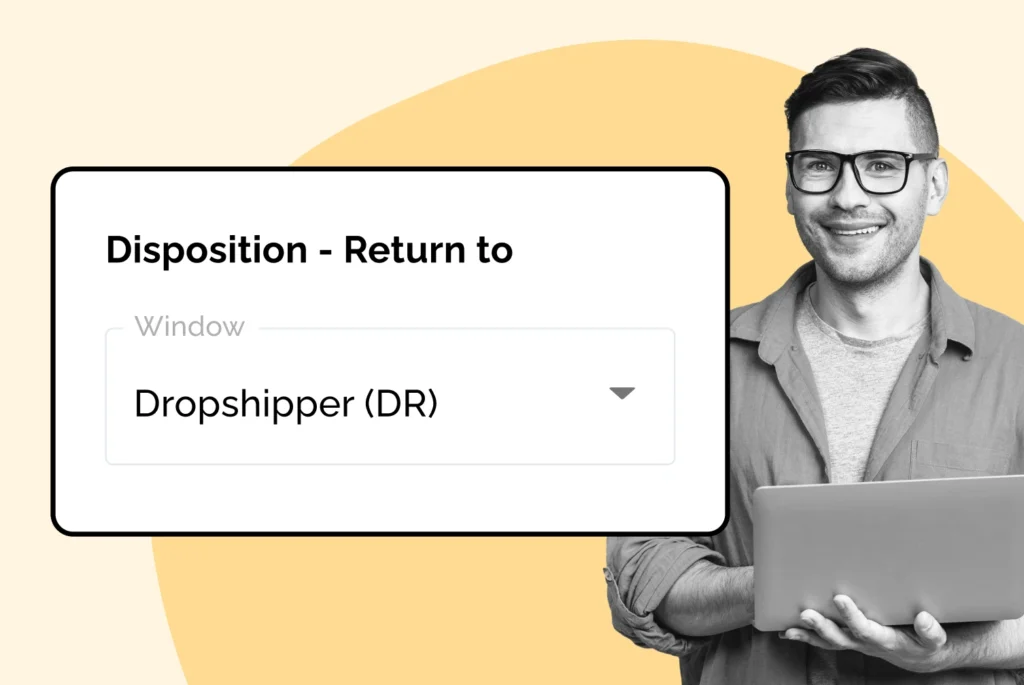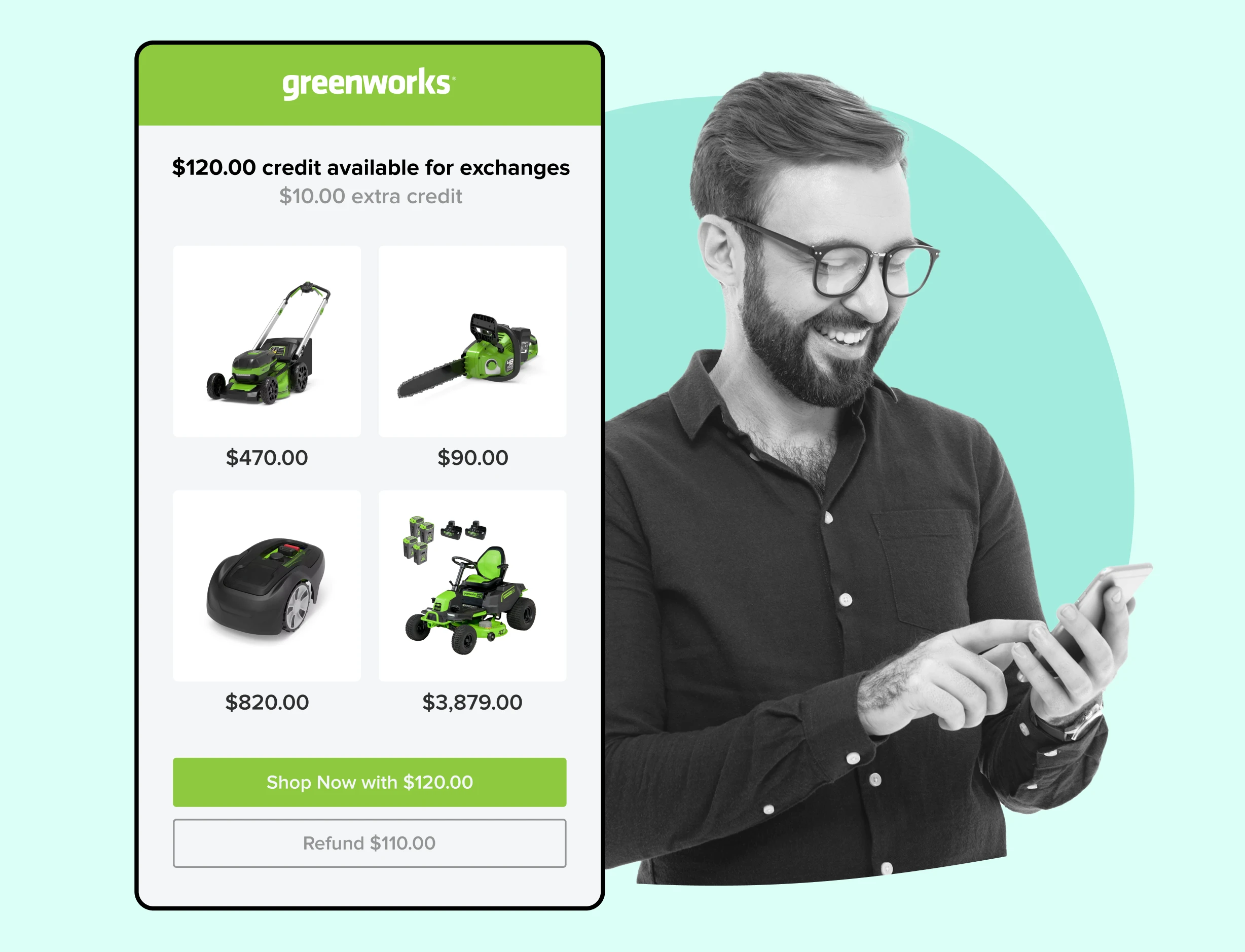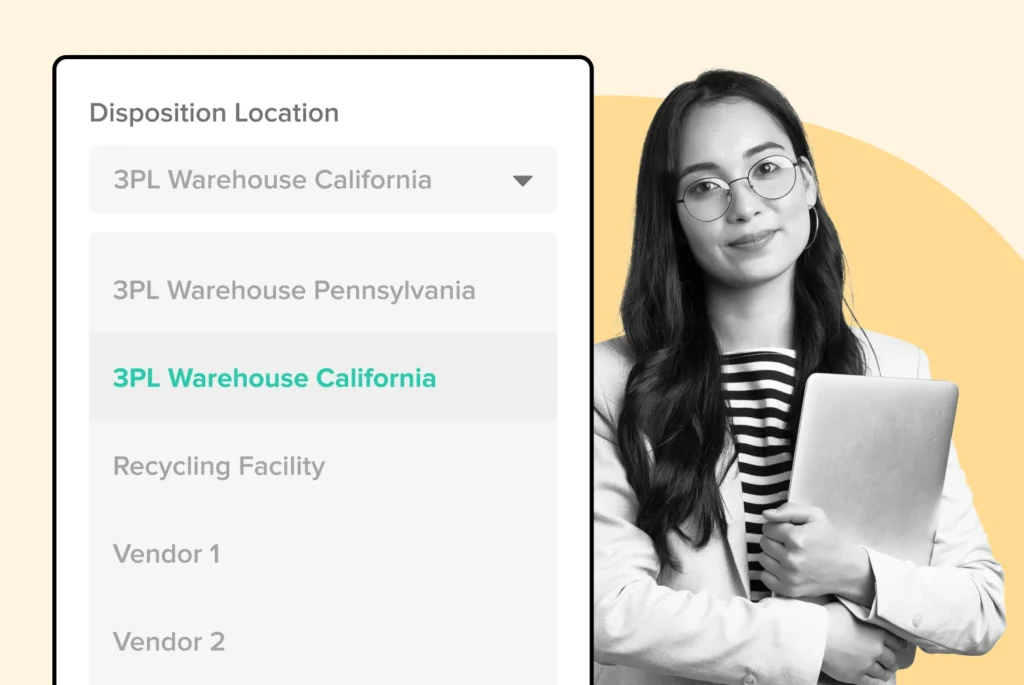
Dropshipping Returns: How to Handle Refunds and More
Managing dropshipping returns requires clear, actionable strategies. Turn them into a source of customer trust rather than frustration!
Shipping, Tracking & Notifications
Boost customer experience and reduce support tickets
Realtime order and shipment tracking
Proactive order and shipping notifications
AI-Enhanced Discounted Labels
Predictive pre-purchase estimated delivery dates
Self-Serivce branded order tracking
Effortless experience delivered
Identify and Resolve Order Issues
Realtime order and shipment tracking
Make returns profitable and delight customers
Flexibility to define any return destinations & conditions
Simplify returns for your customers and team
Incentivize exchanges over returns
Returns management made easy for your team
Returns management made easy for your team
Easy claims and smart upsells
Understand why your customers are returning
In-Store & Curbside Pickup
Unify the online and the in-store experience
Hassle-free pickup experience for customers
In-Store dashboard to keep operations streamlined
In-Store and Online orders unified
Drive foot-traffic to your stores
Shipping, Tracking & Notifications
Boost customer experience and reduce support tickets
Realtime order and shipment tracking
Proactive order and shipping notifications
AI-Enhanced Discounted Labels
Predictive pre-purchase estimated delivery dates
Self-Serivce branded order tracking
Effortless experience delivered
Identify and Resolve Order Issues
Realtime order and shipment tracking
Make returns profitable and delight customers
Flexibility to define any return destinations & conditions
Simplify returns for your customers and team
Incentivize exchanges over returns
Returns management made easy for your team
Returns management made easy for your team
Understand why your customers are returning
In-Store & Curbside Pickup
Unify the online and the in-store experience
Hassle-free pickup experience for customers
In-Store Dashboard to keep operations streamlined
In-Store and Online orders unified
Drive foot-traffic to your stores
Boost customer experience and reduce support tickets
Realtime order and shipment tracking
Proactive order and shipping notifications
AI-Enhanced Discounted Labels
Predictive pre-purchase estimated delivery dates
Self-Serivce branded order tracking
Effortless experience delivered
Make returns profitable and delight customers
Flexibility to define any return destinations & conditions
Simplify returns for your customers and team
Incentivize exchanges over returns
Returns management made easy for your team
Equip your team for precise return checks.
Easy claims and smart upsells
Understand why your customers are returning
Unify the online and the in-store experience
Hassle-free pickup experience for customers
In-Store Dashboard to keep operations streamlined
In-Store and Online orders unified
Drive foot-traffic to your stores
Find the answer to all your questions
Take a step by step trip through our functionality to see how we can improve your ecommerce processes.
Explore the most comon questions about WeSupply
Calculate the ROI that WeSupply can bring you
Read actionable articles on how to optimize your post-purchase experience and decrease support tickets
Get inspired by stories of how our customers implemented an effortless post-purchase experience
Wondering if WeSupply is a good fit for you? Read through our use cases to see how we can help you increase conversion & improve CX!
A Deep Dive into Top Companies' Order Tracking & Returns Strategy
Find the answer to all your questions
Explore the most comon questions about WeSupply
Calculate the ROI that WeSupply can bring you
Request a no strings attached review of your current shopping experience and missed conversion opportunities
Take a step by step trip through our functionality to see how we can improve your ecommerce processes.
Read actionable articles on how to optimize your post-purchase experience and decrease support tickets
Get inspired by stories of how our customers implemented an effortless post-purchase experience
A Deep Dive into Top Companies' Order Tracking & Returns Strategy
Wondering if WeSupply is a good fit for you? Read through our use cases to see how we can help you increase conversion & improve CX!

Navigating the recommerce revolution? This $64 billion market is more than a sustainability trend; it’s a smart business strategy for maximizing profits from returned and second-hand goods. Discover through our comprehensive guide how recommerce is reshaping the retail space, driving economic value, and fostering environmental sustainability. Learn the ins and outs, the striking growth, and the strategies for success that cater to both businesses and consumers.
Recommerce, the practice of reselling previously owned items, has evolved into a sustainable and profitable industry with the potential to reach $64 billion by 2024, driven by consumer interest in sustainability and affordable quality products.
The recommerce market spans various segments including electronics, fashion, and sporting goods, with technology playing a crucial role in facilitating the buying and selling of secondhand items, particularly through online platforms and mobile apps.
Recommerce presents challenges such as slim margins, ensuring product authenticity, and increased competition, yet offers benefits like supporting the circular economy, potential cost savings, and contributing to global recycling efforts.
WeSupply maximizes profits from returns by routing products to recycling centers, donation facilities, or outlet stores. Features include branded portals, self-service returns, flexible rules, Green Returns, automatic labels, printerless returns, in-store/curbside returns, and exchanges. Enhance your returns management and boost profits with WeSupply today!
Recommerce, also known as reverse commerce, is the practice of reselling previously owned items through online marketplaces. This process is not just a trend but a revolution in how we view consumption and waste. It is beneficial for buyers who reuse, recycle, or resell items, creating a sustainable loop that benefits both the economy and the environment.
The recommerce industry has evolved significantly, from traditional swap meets to sophisticated digital platforms, offering new opportunities for businesses and consumers alike. The benefits of recommerce are immense, including financial savings for consumers, reduced waste, and the promotion of sustainable consumption practices.
Recommerce, synonymous with reselling or aftermarket sales, involves the sale of previously owned items that may be:
repaired
refurbished
recycled
resold
reused
This market has expanded from local and in-store sales to powerful digital marketplaces and trade-in schemes. The recommerce sector is projected to reach $64 billion in revenue by 2024, a significant leap from $28 billion a few years prior.
This rapid growth is fueled by younger consumers’ preference for the sharing economy, interest in discounted used goods, and a heightened awareness of environmental sustainability. Recommerce services, including companies like Gazelle and CashForYourMac.com, exemplify how used goods are given a new life, supporting both economic and environmental goals.
Historically, recommerce involved in-person sales at flea markets and garage sales, without the added value of repair or refurbishment services. The rise of digital marketplaces like Craigslist, eBay, and Facebook Marketplace has transformed these traditional person-to-person sales into more accessible and convenient online transactions.
The growth of recommerce is intertwined with the evolution of ecommerce, reflecting a shift from physical swap meets to online platforms. This transition is driven by a combination of increased consumer awareness of sustainability and the convenience of digital marketplaces, making it easier than ever to buy and sell secondhand goods.
WeSupply can help you save significantly by streamlining your returns and exchanges process. By offering a self-service returns process, WeSupply empowers shoppers with complete control, ensuring a frictionless experience that 70% of customers seek. Key features include:
Flexible Returns Rules: Customize return policies to fit various scenarios, eliminating restrictive policies.
Instant Credit for Exchanges: Encourage exchanges instead of refunds, decreasing return rates and boosting order values.
QR Code Return Labels: Simplify returns with QR codes, eliminating the need for printing labels.
Returns Tracking: Allow customers to track their returns easily, enhancing transparency and satisfaction.
Keep your customers engaged during the delivery experience
Book a quick call with our experts to see how WeSupply can help you engage your customers with relevant updates through the right channel, at the right time.
Proactive Notifications: Send high-open-rate post-purchase emails and SMS with return updates and personalized offers.
Automated Returns Management: Streamline returns processing for your team, saving time and effort.
By implementing these features, WeSupply helps businesses create a seamless and efficient returns process, leading to higher customer satisfaction and significant savings. Moreover, WeSupply’s comprehensive approach not only simplifies returns but also significantly enhances your return on investment (ROI). With increased exchanges, reduced support time, and proactive customer engagement, you’ll see substantial improvements in both revenue and customer loyalty.
Ready to see how much you can save? Use our ROI Calculator to discover the financial benefits of streamlining your returns and exchanges with WeSupply today!
The recommerce market in the United States is experiencing a remarkable compound annual growth rate (CAGR) of approximately 14.5% between 2024 and 2030. This growth is driven by:
Heightened consumer awareness of the environmental impact of their purchases
A shift towards sustainable consumer behavior
Economic factors, as consumers seek cost-effective ways to access quality products.
The U.S. secondhand market, one of the emerging markets, grew by 11% in 2023, outpacing the overall U.S. clothing market by sevenfold.
The secondhand fashion market is on a meteoric rise, poised to surpass $200 billion globally. In the U.S., the used clothing market reached $43 billion in 2023, with predictions for the global secondhand apparel market to hit $350 billion by 2028. This surge is fueled by consumers’ growing concerns about sustainability, affordability, and the desire for unique, stylish items.
ThredUp’s analysis points to a valuation of $73 billion for the U.S. secondhand market by 2028. The stigma associated with purchasing used clothing is diminishing, with 76% of survey respondents indicating a reduced negative perception. As consumers increasingly allocate a larger portion of their budget to used clothing, the recommerce market continues to expand, presenting new opportunities for growth and innovation.
Advancements in technology and the rise of online marketplaces and mobile apps have simplified the process for consumers to buy and sell pre-owned items. In 2023, 63% of used apparel shoppers made purchases online, underscoring the significance of technology in driving recommerce. Mobile technology has become a primary driver for recommerce platforms, with major platforms reporting a significant majority of customer traffic coming through mobile devices.
Resale platforms are continually improving their services by incorporating features like consumer protection, user verification, and product authenticity checks, enhancing the simplicity and trustworthiness of recommerce transactions. Brands and retailers recognize the potential of recommerce and are actively entering the market, either managing resale in-house or collaborating with existing second-hand platforms through resale programs.
WeSupply plays a crucial role in this technological transformation by offering solutions that streamline the returns and exchanges processes for merchants. With features like self-service returns, flexible return policies, instant credit for exchanges, QR code return labels, and automated returns management, WeSupply enables businesses to handle returns more efficiently and encourage recommerce. This not only boosts customer satisfaction but also drives profitability and sustainability in the long run.
The recommerce landscape is diverse, encompassing a wide range of products including:
Electronics
Fashion
Sporting goods
Musical instruments
Jewelry
Reputable brands like Skullcandy, Motorola, and Kodak Phones actively engage in the recommerce market, offering various electronic products.
This diversity reflects the broad appeal and potential of recommerce solutions in meeting consumer demands for quality pre-owned goods.
Consumer electronics, including:
wireless headphones
earbuds
speakers
televisions
smartphones
computer accessories
are prevalent in the recommerce market. Platforms like Back Market, which achieved a valuation of $3.2 billion, highlight the significant potential for recommerce platforms specializing in electronics. The recommerce of electronics promotes sustainability by reducing the carbon footprint associated with manufacturing new products.
Refurbished and upcycled electronics are common as consumers seek cost-effective and sustainable alternatives to new devices. Major tech companies like Apple and Canon offer credit for used electronics as part of their trade-in programs, encouraging recommerce.
Retailers like Amazon and Best Buy also contribute to the recommerce ecosystem by providing trade-in options for various electronics.
The fashion and apparel sector dominates the recommerce market, driven by consumer sustainability concerns and the integration of resale platforms for pre-loved items into the fashion ecosystem. Brands like Lululemon and Patagonia are incorporating recommerce into their business models, offering customers the opportunity to trade in gently used gear for gift cards, which are then resold on dedicated websites.
The secondhand apparel market is anticipated to reach $350 billion globally by 2028, with $73 billion expected in the U.S. alone. Two in five apparel items purchased in 2023 were secondhand, reflecting a significant consumer shift towards recommerce in the fashion industry.
Successful recommerce programs in the apparel sector require a focus on:
Sustainability
Quality control
Customer rewards
Seamless integration into brand operations.
Sporting goods and athletic equipment are increasingly being bought and sold through recommerce platforms. Dick’s Sporting Goods, in partnership with SidelineSwap, facilitates the resale of sports equipment through trade-in events, allowing customers to exchange used sports gear for e-gift cards.
This partnership highlights the strategic efforts of major retailers to strengthen their position in the recommerce space.
The musical instrument market caters to both novices and professionals looking for pre-owned instruments. Projected revenues in this market are expected to reach $12.95 billion by 2024, with the United States predicted to generate the most revenue.
Key players like Guitar Center, Sweetwater, and Thomann dominate the market, offering a wide range of secondhand musical instruments to meet diverse consumer needs.
Pre-owned luxury jewelry maintains its timeless appeal in the recommerce market. The global second-hand luxury jewelry market was valued at approximately $860.66 million in 2023 and is forecasted to reach about $1.3 billion by 2028. This growth reflects the enduring value and demand for high-quality, pre-owned luxury items, appealing to both buyers and sellers in the recommerce industry.
The supply chain for recommerce inventory is diverse, with no single source. It includes buyback and trade-in programs where retailers purchase pre-owned products from customers to resell.
This variety of methods for compiling inventory ensures a steady flow of goods into the recommerce market, supporting its growth and sustainability.
Recommerce inventory can originate from various sources, including estate sales, business liquidations, and trade-in programs. Estate sales are a source of inventory where previously owned goods from personal estates are sold after the owner passes away or downsizes. Business liquidations provide inventory when companies sell their assets due to closure, bankruptcy, or restructuring.
Trade-in programs allow consumers to exchange used items for credit or other goods, contributing to recommerce stock. Retailers planning to enter recommerce must decide on the goods to sell, ensuring they align with their current offerings. Implementing a trade in program with a grading scale for product condition can assist in maintaining quality control over inventory.
Flexibility in sourcing goods is essential for success in the recommerce market. Vendors must be open to finding inventory from diverse sources globally to ensure a steady growth without overinvesting in supplies or facing extended delays. Retailers that offer buyback or trade-in programs benefit from reduced acquisition costs and a wider variety of inventory.
A diverse inventory is crucial to meet the varying demands of customers, and businesses must maintain a robust supply chain to deliver products efficiently. Quality control is a key aspect of product sourcing, allowing businesses to uphold their reputation by providing high-quality products to customers. Flexibility in sourcing strategy is critical due to the unpredictable dynamics of supply chains, especially during global events like a pandemic.
Gen Z and millennials are at the forefront of the recommerce movement, driven by their prioritization of sustainability and cost-effectiveness. These younger generations seek out affordable and eco-friendly shopping options, making them critical consumer segments in the recommerce market.
Research by eBay has shown a significant increase in sales of items labeled as ‘thrifted’, indicating the popularity of second-hand goods among younger shoppers. Gen Z, in particular, shows a strong affinity towards sustainability, which is reflected in their consumer behavior. Millennials display the highest frequency of buying pre-owned goods, with notable weekly and monthly purchasing patterns.
Consumers aged 25–34 are most likely to have bought pre-owned goods over the past year, indicating a generational trend. Interest in apparel remains strong among younger consumers, but there’s also an increase in the interest for goods related to collections and hobbies. This demographic shift underscores the importance of targeting younger generations in the recommerce market.
The shift towards second-hand shopping is partly driven by the desire for sustainable and lasting products over new items made from less durable materials like particleboard. Re-commerce contributes to the extension of the life cycle of clothing and accessories, thereby diminishing the necessity for new production and reducing the fashion industry’s carbon footprint.
Brands that integrate re-commerce into their business model can experience increased customer loyalty, improved brand perception, and a new source of revenue. Consumers are provided with affordable and sustainable shopping options through re-commerce, enabling them to support their values without compromising on quality or style. This alignment with the principles of a circular economy helps in minimizing waste and fostering a market for secondhand goods.
WeSupply can significantly enhance your understanding of demographic trends in recommerce through comprehensive returns analytics. By utilizing WeSupply’s returns analytics features, you can:
These features provide valuable insights that help in tailoring your strategies to meet the needs of different customer demographics, ultimately improving customer satisfaction and business efficiency.
Embracing recommerce offers numerous benefits, including promoting sustainability, providing economic advantages, and supporting global recycling efforts. Recommerce can enhance sustainability by shifting from a linear to a circular business model, thereby reducing the usage and waste of raw materials.
Brands that engage in recommerce can improve customer loyalty, as consumers are drawn to companies addressing climate change.
Products in the recommerce market utilize materials that extend the lifetime of items, resulting in lower energy, water, and raw material consumption compared to new products. The environmental impact of reusing existing items, such as clothing and textiles, can be up to 70 times lower than producing new ones.
Through interconnected technology, facilities, and services, firms are enabling brands to make more informed decisions by providing real-time and complete lifecycle analytics, further supporting the circular economy.
WeSupply promotes sustainability and supports the circular economy through its Intelligent Dispositions feature. By dynamically routing returned items to the most appropriate locations, such as recycling centers, donation facilities, or outlet stores, WeSupply ensures that products are reused or recycled rather than discarded. This optimized return process reduces waste, minimizes the carbon footprint, and promotes responsible consumption. Through efficient return management, WeSupply not only lowers costs and enhances customer satisfaction but also contributes to a more sustainable and environmentally friendly retail ecosystem.
Create custom return policies
There are many moving pieces in ecommerce logistics. Book a quick call with our experts to see how WeSupply can help you take control by creating custom policies to handle them all easily. You get to decide how you want to handle final sale items, return window lengths, return request approvals, and more.
Recommerce operations integrated into the returns process can lower costs by selling products that might otherwise be discarded. The growing second-hand market, which recommerce is part of, is expected to reach a value of USD 218 billion by 2026, providing additional sales opportunities.
Consumers are attracted to recommerce for its cost-saving benefits, which align with their interest in bargain hunting and sustainable lifestyles. Businesses can capitalize on consumer preferences for sustainable brands and save money by engaging in the recommerce market. This approach not only enhances profitability but also helps mitigate inflation by offering more affordable options.
Items that may be discarded due to damage, dirtiness, or returns are given a second life in recommerce, preventing them from ending up in landfills. Recommerce practices, particularly refurbishment, resale, and repair, are becoming increasingly prominent in addressing global challenges like climate change and pollution.
The digital devices segment, including laptops and mobile phones, is a significant area of growth for recommerce, helping to combat electronic waste. Telecommunications companies are integrating mobile phone buyback programs into their sustainability strategies to prevent e-waste and encourage environmentally friendly upgrades. In 2022, Foxway processed 1.6 million devices through recommerce, contributing to a significant reduction in environmental impact, specifically a decrease of 121,000 tons of CO2e.
Challenges facing the recommerce industry include slim margins, ensuring product authenticity, and competition from larger players. Determining accurate market value for recommerce goods is challenging due to the lack of a formalized manufacturing process. The recommerce industry is also confronted with issues of product authentication, which can be a time-consuming process that further diminishes profit margins.
Additionally, enterprise companies entering the recommerce market increase competition, making it more difficult for new and smaller businesses.
Recommerce businesses struggle to measure the costs involved in securing items, managing overhead, and handling procurement, all of which influence pricing and profitability. In the recommerce industry, determining the value of time spent securing items, company overhead, and procurement costs plays a significant role in pricing strategies and overall profitability.
Fulfillment costs, including payment processing, can account for a significant portion of e-commerce revenues, often ranging from 12 to 20 percent, which can squeeze margins and challenge profitability. Despite inherent advantages in certain categories, such as higher item value and lower return rates, retailers need to manage key cost drivers and implement strategies across commercial levers to improve e-commerce profitability.
Consumer trust is hindered by the difficulty in ensuring that products, such as electronics and designer goods, are genuine and function correctly. Recommerce platforms face the challenge of authenticating goods, which adds time and costs that further compress margins. Programs like Levi’s Secondhand demonstrate how brands can authenticate their own goods immediately in a recommerce setting.
Investing in personalized relationships with customers by understanding their specific needs can enhance trust in recommerce transactions. Proactively engaging with customers on social media and encouraging their feedback demonstrates a recommerce business’s dedication to customer satisfaction. Continuous improvement based on customer data, feedback, and evolving preferences is necessary for maintaining trust in the recommerce industry.
The presence of large enterprises selling refurbished products has made the recommerce space more competitive for small businesses, including recommerce merchants. Small businesses can differentiate themselves from larger competitors by focusing on niche markets, offering personalized experiences, and providing exceptional customer service.
Embracing technology, such as automating notifications and customizing the returns process, can give small businesses an advantage in customer engagement and operational efficiency. By optimizing their website for search engines, utilizing social media, and running online ads, small businesses can amplify their online presence and compete with larger players.
Online retailers can implement recommerce strategies by integrating a recommerce section on their website or leveraging third-party recommerce platforms. These approaches provide additional exposure and support for recommerce efforts, helping businesses tap into the growing demand for second-hand goods and sustainable shopping options.
Integrating recommerce into an e-commerce ecosystem can be facilitated by using APIs to enable the resale of second-hand goods. Retailers can extend their online shops with platforms for customers to sell their second-hand items, which require user-friendly interfaces and transparent pricing.
Systems and processes must be adapted to check the quality of second-hand products and ensure they meet customer expectations. Merchandise management strategies need to be reconsidered to manage the increased storage and inventory requirements for second-hand items.
The integration of recommerce offers online retailers the potential to reach environmentally conscious consumers who are interested in second-hand products and sustainable practices.
Third-party recommerce platforms can significantly increase a business’s exposure by connecting them with a vast user base that may be unfamiliar with the brand. Using multiple third-party platforms allows businesses to diversify their online sales revenue and mitigate against risks.
Platforms like ThredUp and Poshmark offer comprehensive resale solutions, handling logistics like shipping and returns, and providing marketing services, which reduces the operational burden on the online retailer’s staff. By participating in global third-party ecommerce platforms, online retailers can open up opportunities to sell internationally and expand their market reach.
WeSupply empowers online retailers to implement effective recommerce strategies by providing a seamless and efficient returns process, WeSupply helps retailers manage and monetize returned products more effectively. Key features include:
Self-Service Returns Process: Enable customers to control their return process, saving time and increasing satisfaction.
Flexible Returns Rules: Develop hassle-free return policies tailored to various scenarios.
Green Returns: Allow customers to keep low-cost items, saving on return labels and enhancing satisfaction.
Automatic Return Labels: Generate return labels automatically, ensuring efficiency even during staff absences.
Printerless Returns via QR Code: Enhance customer experience with QR code-based return shipping.
In-Store or Curbside Returns: Offer convenient return options similar to major retailers.
Convert Returns to Exchanges: Encourage store credits over refunds to retain revenue.
Returns Tracking: Provide customers with easy access to track their return status.
Integrations: Seamlessly connect with hundreds of third-party tools for a superior customer experience and cost savings.
With these features, WeSupply enables retailers to adopt sustainable recommerce practices while maximizing efficiency and customer satisfaction. Experience the future of returns management! Book a demo with WeSupply today!
Reflecting on the benefits and challenges discussed, it is clear that embracing recommerce is not just a trend but a vital component of a sustainable future. By promoting the reuse of products, reducing waste, and conserving resources, recommerce supports the principles of the circular economy and offers significant economic and environmental benefits.
Encouraging a shift towards more sustainable consumer practices, recommerce provides businesses with new opportunities to engage with environmentally conscious consumers and expand their market reach. As we move forward, the integration of recommerce solutions will be crucial in creating a more sustainable and equitable future for all.
In summary, the recommerce market is experiencing rapid growth, driven by consumer demand for sustainable and cost-effective shopping options. From electronics to fashion, sporting goods to luxury jewelry, recommerce encompasses a wide range of products, offering significant benefits for both consumers and businesses.
WeSupply helps online retailers maximize profits from returned products with effective recommerce strategies. By using Intelligent Dispositions, WeSupply routes returns to recycling centers, donation facilities, or outlet stores, ensuring products are reused or recycled. This process reduces waste, lowers costs, and boosts customer satisfaction, promoting sustainability and supporting the circular economy. WeSupply offers a branded returns portal, a self-service returns process, flexible returns rules, Green Returns, automatic return labels, printerless returns via QR code, in-store or curbside returns, and conversion of returns to exchanges. Customers can easily track their returns, and seamless integration with third-party tools enhances the overall experience. Start maximizing your returns and increasing your profits with WeSupply today!
Recommerce, also known as reverse commerce, is the process of buying and selling pre-owned goods through online marketplaces, promoting reuse, recycling, and reselling to extend the lifecycle of products.
The recommerce market in the U.S. is expected to grow at a CAGR of approximately 14.5% between 2024 and 2030, driven by consumer awareness of environmental impacts and economic factors. This indicates a significant expansion in the coming years.
Electronics, fashion and apparel, sporting goods, musical instruments, and luxury jewelry are popular products in recommerce. These items are in high demand for resale.
Recommerce offers businesses various benefits such as promoting sustainability, providing economic advantages, supporting global recycling efforts, and improving customer loyalty. It can be a valuable strategy for businesses looking to enhance their operations.
WeSupply promotes sustainability by ensuring returned products are reused or recycled rather than discarded. This process reduces waste, minimizes the carbon footprint, and supports responsible consumption, contributing to a more environmentally friendly retail ecosystem.
Green Returns allow customers to keep low-cost items when requesting a return, saving money on labels and enhancing satisfaction by providing quick refunds or exchanges without requiring the return of certain items.
WeSupply encourages customers to take store credits over refunds, helping retailers retain revenue by converting returns into exchanges.
Yes. WeSupply has an Official Shopify App. You can download it and start integrating with your Shopify Store.
Yes, WeSupply has an official extension for Magento. The WeSupply x Magento integration allows for automating order tracking experiences, reducing customer inquiries, automating shipping email and SMS notifications, and providing a fully branded order tracking experience
Yes, WeSupply has an official BigCommerce App. You can integrate WeSupply with your BigCommerce store to improve your post-purchase customer experience.

Learn How To Create Successful Post Purchase Email Campaigns
Build an effective post-purchase email flow that helps you increase customer satisfaction and drive revenue growth!

Managing dropshipping returns requires clear, actionable strategies. Turn them into a source of customer trust rather than frustration!
Let’s explore how tracking systems can enhance customer satisfaction, improve operational efficiency, and provide valuable business insights!

Learn the tangible benefits this integration delivers, as we unpack the advantages and practical steps of merging these powerful tools.

Discover how to refine your returns process, address common issues, and emerge as a leader in a customer-centric market!

The top benefits of utilizing a 3PL for your return warehousing needs and how it impacts your overall e-commerce strategy!

Master omnichannel returns: shape a smoother experience for your customers and foster loyalty to propel business growth!

Navigate customs with ease, select the best USPS services, and manage your shipping expenses without sacrificing speed or reliability!

Launching and maintaining international operations successfully: the knowledge of trade compliance, customs laws, taxes, and more!

How to navigate the return process, and tips for ensuring your experience with online returns is as smooth as possible!